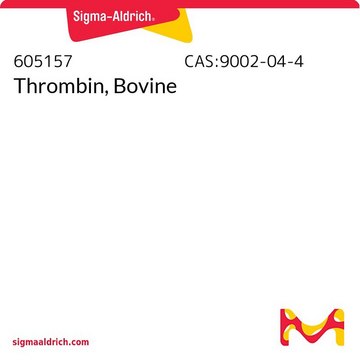T7326
Trombina
≥60 NIH units/mg protein (biuret)
Sinônimo(s):
Fator IIa
Faça loginpara ver os preços organizacionais e de contrato
About This Item
Número CAS:
Número MDL:
Código UNSPSC:
12352204
NACRES:
NA.54
Produtos recomendados
forma
lyophilized powder
Nível de qualidade
atividade específica
≥60 NIH units/mg protein (biuret)
composição
Protein, ≥50%
temperatura de armazenamento
−20°C
Procurando produtos similares? Visita Guia de comparação de produtos
Descrição geral
Thrombin is the final coagulation protease in regard to hemostasis, promoting both procoagulant and anticoagulant effects. Thrombin comprises of A-chain and B-chain with the catalytic pocket. The C-terminal regions has a fibrinogen recognition site (FRS) and a heparin binding site (HBS). The main function of thrombin is cleavage of fibrinogen to fibrin. It coordinates the coagulation cascade and coordinates with protease-activated receptors (PARs) to regulate physiological functions. High levels of thrombin causes neurotoxicity in dopaminergic neurons and contribute to the progression of parkinsons disease. Altered thrombin levels modulates coagulation pathway in multiple sclerosis. Patients with coronary artery disease (CAD) show elevated levels of thrombin.
Aplicação
Thrombin from bovine plasma may be used:
as revitalization model to mimic blood fabrication in root canal
- for the generation of fibrin from fibrinogen embedded in microbubbles
- for the cleavage of hydrogenase maturation protein (HypF-N) from the nickel resin
as revitalization model to mimic blood fabrication in root canal
Thrombin is used for site specific cleavage of recombinant fusion proteins containing an accessible thrombin recognition site for removal of affinity tags. Thrombin has been used in a study to evaluate coagulation abnormalities in acute liver failure.
Ações bioquímicas/fisiológicas
Protease de serina que cliva seletivamente ligações Arg-Gli do fibrinogênio para formar fibrina e fibrinopeptídeos A e B.
Definição da unidade
Activity is expressed in NIH units obtained by direct comparison to a NIH thrombin reference standard.
forma física
Lyophilized powder containing sodium chloride and Tris-HCl, pH 7.0
Nota de preparo
Traditional thrombin products are activated with bovine brain thromboplastin, whereas T7326 is activated with bovine lung thromboplastin and does not contain any bovine brain products in its preparation.
Nota de análise
A atividade é expressa em unidades do NIH, obtidas por comparação direta com um padrão de referência de trombina do NIH, Lote K.
O procedimento de ensaio do NIH (Institutos Nacionais de Saúde dos Estados Unidos) usa 0,2 ml de plasma diluído (1:1 com soro fisiológico) como substrato e 0,1 ml de amostra de trombina (estabilizada em solução tamponada de albumina a 1%) com base em uma modificação do método de Biggs. São usados para determinar as concentrações de trombina somente os tempos de coagulação na faixa de 15-25 segundos.
Outras notas
View more information on thrombin at www.sigma-aldrich.com/enzymeexplorer.
Código de classe de armazenamento
11 - Combustible Solids
Classe de risco de água (WGK)
WGK 3
Ponto de fulgor (°F)
Not applicable
Ponto de fulgor (°C)
Not applicable
Equipamento de proteção individual
Eyeshields, Gloves, type N95 (US)
Certificados de análise (COA)
Busque Certificados de análise (COA) digitando o Número do Lote do produto. Os números de lote e remessa podem ser encontrados no rótulo de um produto após a palavra “Lot” ou “Batch”.
Já possui este produto?
Encontre a documentação dos produtos que você adquiriu recentemente na biblioteca de documentos.
Os clientes também visualizaram
Increased plasma thrombin potential is associated with stable coronary artery disease: An angiographically-controlled study
Tosi F, et al.
Thrombosis Research, 155, 16-22 (2017)
Banwari Agarwal et al.
Journal of hepatology, 57(4), 780-786 (2012-06-28)
In acute liver failure (ALF), prothrombin time (PT) and its derivative prothrombin time ratio (PTR) are elevated, and are considered predictors of increased bleeding risk. We aimed at determining whether increased PT/PTR reflects the haemostatic potential and bleeding risk in
Backbone NMR assignments of HypF-N under conditions generating toxic and non-toxic oligomers
Patel JR, et al.
Biomolecular NMR Assignments, 1-5 (2018)
A training model for revitalization procedures
Widbiller M, et al.
International Endodontic Journal, 51, e301-e308 (2018)
Fibrin-Targeted Polymerized Shell Microbubbles as Potential Theranostic Agents for Surgical Adhesions
Gormley CA, et al.
Langmuir (2019)
Nossa equipe de cientistas tem experiência em todas as áreas de pesquisa, incluindo Life Sciences, ciência de materiais, síntese química, cromatografia, química analítica e muitas outras.
Entre em contato com a assistência técnica










